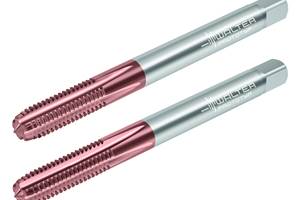A Tool To Help With Jaw Boring
Machining soft jaws remains one of the most tedious and time-consuming tasks for turning centers, so anything you can do to organize and simplify this task will speed up your setups. In order to make the workholding setup when soft jaws must be machined, the setup person must remove the current top tooling from the chuck, find the set of jaws to be used for the new setup, mount the jaws to the chuck, clamp on some form of temporary plug or ring, and machine the jaws.
Share





Hwacheon Machinery America, Inc.
Featured Content
View More
Machining soft jaws remains one of the most tedious and time-consuming tasks for turning centers, so anything you can do to organize and simplify this task will speed up your setups. In order to make the workholding setup when soft jaws must be machined, the setup person must
- remove the current top tooling from the chuck,
- find the set of jaws to be used for the new setup,
- mount the jaws to the chuck,
- clamp on some form of temporary plug or ring, and
- machine the jaws.
A little organization will go a long way to minimizing the setup time related to getting soft jaws ready to use. Convenient and organized jaw storage, for example, can minimize much of the searching a setup person must do in order to find and store jaws. It should go without saying that setup people must put jaws back where they belong when they're removed from the chuck. As basic as this sounds, I'm always amazed by companies that do little or nothing when it comes to organized jaw storage. I've seen many setup people search the shop (taking a great deal of time) to find a needed set of jaws.
When it comes to mounting jaws, the style of chuck determines what is involved with jaw placement. Some chucks require cumbersome methods. The serrations on the jaws are commonly quite fine, making the jaws difficult to place precisely. A series of rings on the face of the chuck must be used to help with placement. Two cap screws per jaw must be tightened. If a jaw is misplaced, the whole process must be repeated. I've seen novice setup people take thirty minutes just to place a set of three jaws on the chuck.
By comparison, quick jaw-change chucks make jaw placement much easier and faster. The serrations of these jaws are usually coarser, making proper placement considerably easier to judge. A tee-wrench is used to help mount each jaw. In many cases, jaws can be easily placed on the chuck in less than ten seconds per jaw.
Once jaws are mounted, most applications require that they be machined to ensure concentricity with the main spindle. In order to bore jaws to the proper size, the setup person must first clamp the jaws on a temporary plug so that the master jaws are close to about the middle of their stroke. Again, some organization and prior thought can save countless hours of setup time. A great deal of setup time can be wasted while the setup person searches the shop for an appropriately sized chucking plug. Worse, you may have to make one to fit the jaws.
One solution to this problem is to keep a set of chucking plugs close by each turning center. Make them in 1/8-inch diameter increments to ensure that setup people always have an appropriately sized plug at their fingertips.
An attendee from one of my seminars suggested making an adjustable tool from hex stock. Having this tool in two or three sizes will usually handle all the jaws you bore. Notice the hole in the middle of the tool. It's used to line up the center of this plug with a series of concentric circles drawn on a piece of paper. If the circles are clearly marked (in 1/8-inch increments), the setup person can quickly and precisely set the adjustable screws to provide the appropriate chucking diameter.
The actual act of boring the jaws has been the topic of previous CNC Tech Talk columns (September 1991 and July 1996), so only the main points will be repeated here. First, programming the jaw boring process will minimize setup time. A parametric program can even be developed to allow the jaw size to be quickly specified prior to boring. Second, if you do bore jaws manually, be sure you calibrate the position display page to match the tool's position. This will keep setup people from guessing at diameters and depths that are being machined.
Related Content
Ceratizit Product Update Enhances Cutting Tool Solutions
The company has updated its MaxiMill 273-08 face mill, WPC – Change Drill, as well as the HyPower Rough and HyPower Access 4.5-degree hydraulic chucks.
Read MoreKay Engineering's Gundrilling Machine Performs Range of Operations
Kay Engineering’s DeHoff 20144 is used to perform gundrilling, pull boring, roller burnishing and thread tapping.
Read MoreWalter Offers New Solid-Carbide Taps for Blind-Hole Machining
Walter’s TC388 Supreme and TC389 Supreme feature patent-pending cutting geometries that fully shear off the root of the chip when reversing, thus minimizing torque peaks.
Read MoreCustom PCD Tools Extend Shop’s Tool Life Upward of Ten Times
Adopting PCD tooling has extended FT Precision’s tool life from days to months — and the test drill is still going strong.
Read MoreRead Next
Building Out a Foundation for Student Machinists
Autodesk and Haas have teamed up to produce an introductory course for students that covers the basics of CAD, CAM and CNC while providing them with a portfolio part.
Read More5 Rules of Thumb for Buying CNC Machine Tools
Use these tips to carefully plan your machine tool purchases and to avoid regretting your decision later.
Read MoreRegistration Now Open for the Precision Machining Technology Show (PMTS) 2025
The precision machining industry’s premier event returns to Cleveland, OH, April 1-3.
Read More
.jpg;width=70;height=70;mode=crop)
































.png;maxWidth=300;quality=90)



.jpg;maxWidth=300;quality=90)










